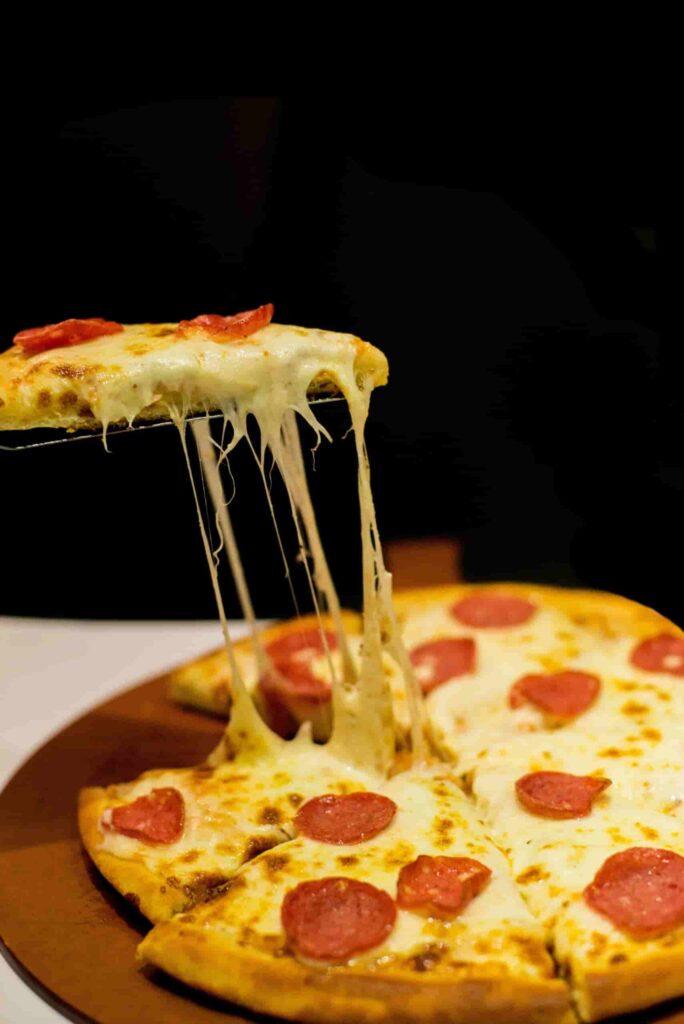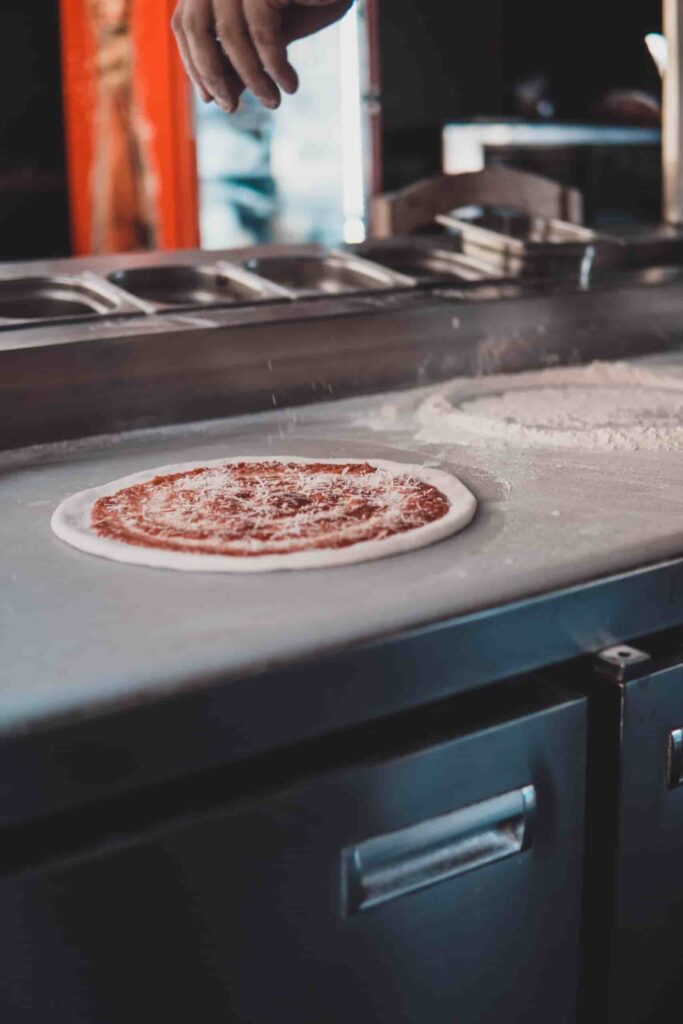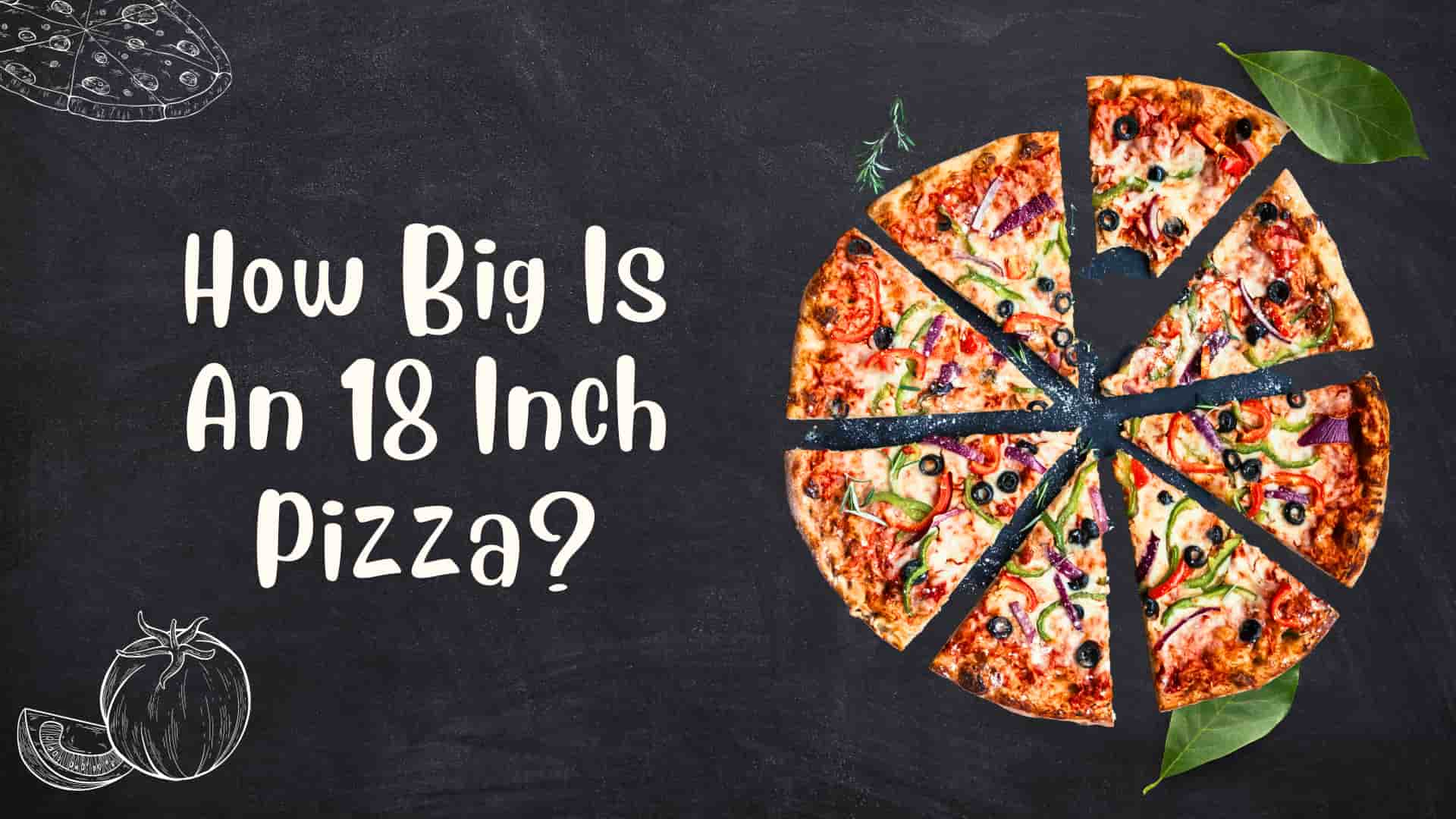The 18 inch pizza is characterized by its expansive size, making it an extra-large option in the pizza spectrum. With a diameter of 18 inches, this pizza provides ample space for a variety of toppings, accommodating diverse preferences. Its substantial serving size, often yielding 12 to 16 slices, makes it an ideal choice for larger gatherings, parties, or sharing among a group of people.
Table of Contents
Breaking Down the Dimensions
When we talk about an 18 inch pizza, the measurement refers to the diameter of the pizza, taken from one edge to the other, passing through the center. So, the entire pizza spans 18 inches across.
Now, if you’re more of a visual person, imagine a standard adult bicycle tire or a large car tire. That’s roughly the size of an 18-inch pizza. It’s a size that’s impressive and perfect for sharing.
The Area Factor

To truly understand the size of an 18-inch pizza, consider its total area. Using the formula for the area of a circle , an 18-inch pizza covers about 254 square inches. Compare this to a standard 12-inch pizza, which offers roughly 113 square inches, and you can see that the 18-inch pie offers more than double the pizza goodness.
Slice by Slice
A standard 18 inch pizza typically gets sliced into 8 or 12 pieces. This means each slice is a hearty piece, with a length from the crust to the tip of the slice being about 9 inches (half the diameter) if sliced into 8 pieces.
Feeding a Crowd
So how many people can an 18 inch pizza serve? This largely depends on individual appetites and what else is being served. On average:
- For children: An 18 inch pizza can serve 8-12 kids.
- For adults: It can serve 4-6 adults, considering an average adult might eat 2-4 slices.
Of course, if pizza is the main dish without many side options, you might lean towards the higher end of these estimates.
Value for Money: Price Advantage
One of the reasons for the popularity of 18 inch pizzas, apart from its impressive size, is its value for money. When you break down the cost per square inch, larger pizzas often offer better value than their smaller counterparts. So, if you’re looking to get the most pizza for your buck, going big is a smart choice.
The Topping Territory

Another advantage of an 18 inch pizza is the vast expanse available for toppings. More surface area means more space for delicious toppings, cheeses, and sauces. This can lead to a more flavorful and diverse bite, especially if you love a variety of toppings on your pizza.
The 18 inch pizza is more than just a size; it’s an experience. Perfect for gatherings, parties, or just a night in with family or friends, it offers a generous expanse of deliciousness that’s hard to beat. Whether you’re a meat lover, vegetarian, or somewhere in between, this size ensures every bite is as delightful as the last.
The 18 inch Pizza: A Deep Dive
An 18 inch pizza is one of the larger sizes available at most pizzerias. It’s an excellent choice for parties or large gatherings.
- Area: The area of a circle is calculated using the formula: Area = πr^2. For an 18-inch pizza, the radius (r) is half the diameter, or 9 inches. This gives us an area of about 254.47 square inches.
The 12 inch Pizza: The Standard
The 12 inch pizza is often considered the “standard” or “medium” pizza in many establishments.
- Area: With a 6-inch radius (half of 12 inches), the area of a 12-inch pizza is approximately 113.10 square inches.
The 16 inch Pizza: The Middle Ground
A 16 inch pizza is a great middle-ground option, offering significantly more pizza than a 12-inch but not quite as much as the 18-inch.
- Area: With an 8-inch radius, the area of a 16-inch pizza is around 201.06 square inches.
Estimating Calories in an 18-inch Pizza
With the increasing awareness about health and nutrition, many pizza aficionados find themselves asking, “How many calories are in my pizza?” Here, we will discuss the calories in an 18 inch pizza, keeping in mind that toppings, crust thickness, and preparation methods can vary.

However, we can provide a ballpark estimate:
- Basic Cheese and Tomato Pizza: An average slice of an 18-inch cheese and tomato pizza might contain between 250-350 calories. With typically 12 slices in an 18-inch pizza, the total calorie count ranges from 3,000 to 4,200 for the entire pie.
- Meat Toppings: Each slice with meat toppings like pepperoni, sausage, or bacon can add anywhere from 30-100 additional calories per slice, depending on the quantity and type of meat.
- Vegetable Toppings: Vegetables add fewer calories, typically adding between 5-20 calories per slice, depending on the type and amount.
Comparing with Other Pizza Sizes
For context, it’s helpful to compare the 18 inch pizza with its smaller counterparts:
- A standard slice of a 12-inch pizza generally ranges between 200-300 calories for a basic cheese and tomato version.
- A 16-inch pizza slice usually falls between 230-320 calories for the same variety.
It’s evident that as pizza size increases, so does the calorie count for each slice, given the larger surface area and quantity of toppings.
Comparing 18 inch Pizzas to Other Sizes:
Let’s put the size of an 18-inch pizza into perspective by comparing it to other popular sizes. Here are the diameters, radii, circumferences, and areas of different pizza sizes:
| Size | Diameter | Radius | Circumference | Area |
|---|---|---|---|---|
| 12 inches | 12 inches | 6 inches | 37.68 cm | 113.04 cm^2 |
| 14 inches | 14 inches | 7 inches | 43.92 cm | 159.36 cm^2 |
| 16 inches | 16 inches | 8 inches | 50.16 cm | 201.36 cm^2 |
| 18 inches | 18 inches | 9 inches | 56.32 cm | 254.84 cm^2 |
| 20 inches | 20 inches | 10 inches | 62.88 cm | 314.16 cm^2 |
As you can see, an 18-inch pizza falls between the 16-inch and 20-inch sizes in terms of diameter, radius, circumference, and area. It offers a significant increase in size compared to smaller pizzas, but isn’t quite as large as the biggest sizes available
Making Healthier Choices
If you’re calorie-conscious, here are some tips for enjoying pizza without overindulgence:
- Opt for a thin crust.
- Choose vegetable toppings over meat.
- Be mindful of cheese quantities.
- Avoid extra oil or butter on the crust.
- Consider serving pizza with a side salad to balance your meal and reduce the number of slices you consume.
The Dough Down: Comparing 18 inch Pizza, 16 inch, and 12 inch pizzas
The Basics of Pizza Measurement
Before diving into the dough specifics, it’s essential to understand that pizzas are usually measured by their diameter. A 12 inch pizza means it’s 12 inches from one side to the other. However, when we talk about surface area, the game changes. The surface area dictates how much topping, sauce, and, yes, dough you’ll need.
The formula for the area of a circle is π times the radius squared. So, the bigger the diameter, the more significant the jump in surface area, even if it doesn’t look that much bigger visually.
12 inch Pizza: The Standard
A 12 inch pizza is often deemed the “medium” size in many pizzerias. For this size, you generally require:
- Dough: About 8 to 10 ounces (227 to 283 grams)
This size is perfect for a couple of people and is manageable for most ovens and pizza stones.

16 inch Pizza: Moving Up
The 16 inch pizza is a common “large” size at many pizza joints. This size requires a heftier dough amount to maintain the same crust thickness. For a 16-inch pizza, you’d typically need:
- Dough: Roughly 16 to 20 ounces (454 to 567 grams)
It’s crucial to note that a 16-inch pizza has more than double the surface area of a 12-inch pizza. Hence, the dough requirement doesn’t linearly increase with the diameter.
18 inch Pizza: The Family Size
An 18-inch pizza is usually dubbed as an “extra-large” pizza. Ideal for family gatherings or parties, this pizza size can comfortably serve multiple people. For this diameter, the standard dough requirement is:
- Dough: Approximately 20 to 24 ounces (567 to 680 grams)
Again, considering the surface area, an 18-inch pizza doesn’t need twice as much dough as a 12-inch pizza but is considerably more than a 16-inch one.
[sp_easyaccordion id=”3115″]
